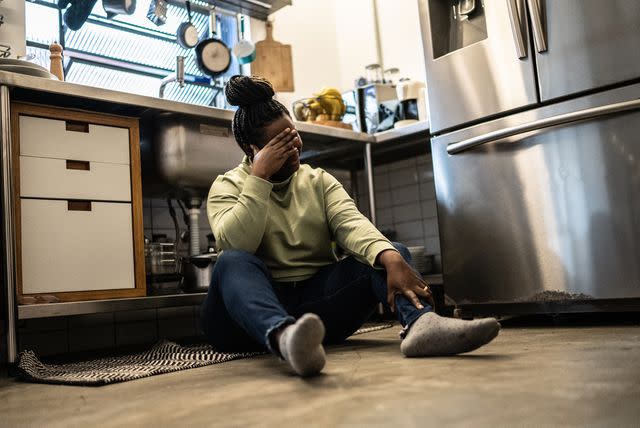Are There Stages of Depression?
A way to classify symptom progression
Medically reviewed by Aleesha Grier, PsyD
Depression is a serious mental health condition with variable symptoms. Some people describe its progress in stages. However, there is no research to support depression in stages.
This article will discuss depression and how some people have tried to develop stages of depression. It will also cover depression treatment and how to find help for someone experiencing depression symptoms.

FG Trade / Getty Images
Stages of Progressive Depression
A popular belief is that depression is categorized into stages. While this has not been supported by research, a study published in 2021 found that people believe depression moves through phases of severity.
A 2017 essay suggests that depression should be broken up into stages. The author argues that fitting all depression diagnoses in a one-size-fits-all category leads to unneeded or inappropriate treatment of certain individuals. The author suggests these three stages of depression:
Distressed
Severe symptoms
Chronic or refractory (does not respond to medical treatment)
Depression can be experienced in different ways for different people. A healthcare provider specializing in mental health can help identify symptoms of depression, determine a diagnosis, and provide treatment specific to each person's needs.
Similarities to Stages of Grief
Depression is sometimes described as having stages, which is likely due to depression as a part of the stages of grief.
The psychiatrist Elisabeth Kübler-Ross developed the stages of grief, a theory that someone who has experienced the loss of a loved one will move through five distinct stages as they grieve. They may not go through the stages in a particular order, and they may return to various stages.
The stages of grief identified by Kübler-Ross are:
Denial
Anger
Bargaining
Depression
Acceptance
Depression is not categorized by stages but by types. Each type is unique in its presentation of symptoms, people it affects, and stages of life when it presents.
Episodes of Depression
An episode of depression is when a person experiences the symptoms of depression like feeling sad, irritable, and loss of interest. Episodes of depression typically last five to seven months and can be categorized as one of the three patterns described below:
Single episode disorder: A person only experiences one depressive episode.
Recurrent episode disorder: A person has a record of two or more depressive episodes.
Bipolar disorder: A person has depressive episodes that switch off with manic episodes.
Depressive episodes develop through a combination of psychological, biological, and social elements. Life events, like the loss of a loved one, can be a trigger that initiates the depressive episode.
While it may not be possible to avoid all episodes of depression, seeking help from a healthcare provider can deliver a diagnosis. With a diagnosis in hand, a healthcare provider will develop a treatment plan and coping strategies to help reduce the symptoms and in some cases shorten the duration of the depressive episode.
Different Types of Depression
Depression is a mental health condition that changes how a person thinks, feels, and handles everyday activities. Depression is classified as different types. However, there are no stages. The different types of depression include:
Major depressive disorder: Loss of interest or depressed mood that interferes with normal activity most of the time for at least two weeks
Seasonal affective disorder: Depression that begins in the fall or early winter and continues until spring or summer
Persistent depressive disorder: Depressive symptoms that tend to be less severe than in major depressive disorder but last for a long time, generally for at least two years
Depression with psychosis: Depression with symptoms of psychosis which include hallucinations or delusions
Perinatal depression: Depression that begins during or after pregnancy
Depression Statistics
Depression affects approximately 5% of adults worldwide.
Treatment for Depression
Depression is typically treated with either medication or psychotherapy, or both. Each person will respond differently to treatment, so it may take time to find the right treatment. The modes of therapy include:
Medication: Antidepressant medications change certain chemicals in the brain to improve mood. They do not work right away; it can take four to eight weeks to see results. It's crucial to give the medication time to work before deciding on its effectiveness.
Psychotherapy: Also known as counseling or therapy, psychotherapy works by teaching people new ways to behave, think, or change their habits surrounding depression.
Brain stimulation therapy: This treatment is typically reserved for people who do not respond to medication or psychotherapy. It works by blocking or activating areas of the brain with electricity. It can be performed by implanting electrodes in the brain or placing electrodes on the scalp.
Professional Support and Additional Resources
If someone suspects they or someone they know has depression, they should seek professional support from a healthcare provider.
This could mean contacting a primary healthcare provider, psychiatrist, psychologist, or social worker. These professionals will be able to diagnose depression or help find the right person to provide treatment.
Reach out to healthcare providers and social workers for information about local resources and support groups.
Getting Help
If you think you may be in a position to harm yourself or someone else, call 911 or your local emergency number ASAP. Several treatment resources and support groups can be sought through the Substance Abuse and Mental Health Service Administration (SAMHSA) National Hotline at 1-800-662-HELP (4357).
If you are having suicidal thoughts, dial 988 to contact the 988 Suicide & Crisis Lifeline and connect with a trained counselor. If you or a loved one are in immediate danger, call 911.
Summary
Depression is a mental health condition that causes feelings of helplessness, sadness, and loss. It can develop in anyone at any time. While there are no stages of depression, there are various types of depression.
Several treatment options are available, including medication and therapy. Contact a healthcare provider if you are feeling symptoms of depression to get the right help fast.
Read the original article on Verywell Health.

